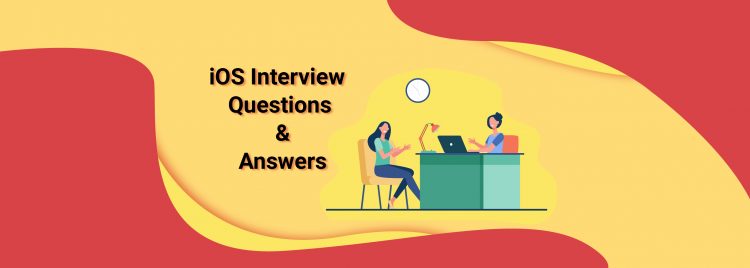Introduction to iOS interview Questions & Answers
Best iOS interview questions it is the most advanced smart operating system in the world. With iOS 15, you can create applications that use SharePlay to connect people in new ways, new notification API’s to help users focus on the moment, and augmented reality, Safari extensions, and nearby interactions to give new tools for exploration. With the newest App Store features, you can further increase the discovery of your app on the App Store, give better in-app purchase experiences, and much more.
We’ve all heard the acronym iOS hundreds of times and also in the iOS interview questions & answers. iOS is an abbreviation for “iPhone Operating System.” It is the operating system for Apple devices and is regarded as the world’s second most popular mobile operating system behind Android. Many of Apple’s products, including the iPhone, iPad, and iPod, run on this operating system. iOS is frequently lauded for its simple and easy-to-use interface.
The iOS Platform includes the following features:
In iOS interview questions this has grown in popularity as a result of its major features. Here are a few of its most noticeable characteristics:
- The iPhone is capable of multitasking. You may effortlessly move between applications on an iOS device by utilizing the multitasking function or a multi-finger gesture.
- By presenting an activity stream and sharing information, iOS makes it simple to incorporate social network interactions with your app.
- Users may save data on the Internet using Apple’s iCloud service. It provides a high level of encryption as well as a backup option to ensure that the user’s data is not lost.
- In-app purchases from Apple are available across all platforms, providing customers with additional services and materials such as digital products (iOS, iPad, macOS), subscriptions, and premium content.
iOS Interview Questions for Freshers
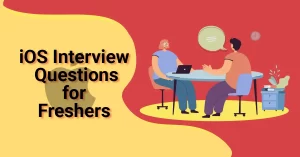
Explain the iOS Technology/Architecture.
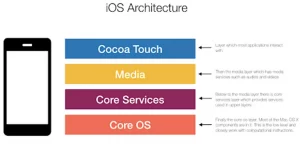
iOS has a layered architecture. The iOS Architecture is divided into four levels, each of which provides a programming foundation for developing programs that run on top of the hardware. The levels between the Application Layer and the Hardware Layer will improve communication. A lower-level layer offers services required by all programs, whereas an upper-level layer (or high-level layer) delivers graphics and interface-related functions.
- Core OS (or Application) Layer: The Core OS Layer is the bottom layer of the iPhone OS stack and sits directly on top of the device hardware. This layer enables low-level networking, access to external accessories, and other services in addition to core operating system functions like memory management, file system and thread handling.
- Service Object- The objective of the Service Layer is to design the services that upper levels or users require. Block objects, Grand Central Dispatch, in-app purchases, and iCloud storage are among its other major features. The implementation of ARC Automatic Reference Counting has enhanced the service layer.
- Media Layer: It is in charge of media such as video, audio, graphics, and so on. The media layer will allow us to leverage the system’s graphics, video, and audio technologies.
- Cocoa Touch Layer : The Cocoa Touch Layer is often referred to as the application layer. When applications are generated, frameworks are created in this location. It also serves as an interface for iOS users to interact with the operating system. This includes the ability to use touch and motion.
What is GCD?
GCD is an abbreviation for Grand Central Dispatch. It is a low-level API that allows you to manage numerous operations at the same time. Here in this iOS interview questions it will help you improve your app’s performance by postponing computationally costly activities to the context. It’s a less complicated concurrency paradigm to deal with than locks and threads.
Could you perhaps clarify the distinction between atomic and nonatomic properties? What is the standard value for synthesized properties?
Atomic Property: This is the default property and ensures that a valid value is returned by the getter or set by the setter. This assures that only one thread may access a particular property’s getter/setter at a time, and that all other threads must wait until the first thread releases the getter/setter. Despite the fact that it is thread-safe, it is not quick since it assures that the task is finished entirely.
Non-Atomic Property: Because many threads can access the getter/setter method of a particular property at the same time, the possibility of value inconsistency occurs.
What are the many kinds of iOS Application States?
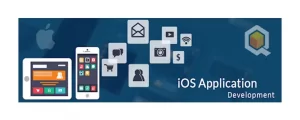
An iOS application goes through a succession of stages during its operation. Each of these phases is referred to as the lifecycle state of an application. The five potential states for an iOS interview questions app are as follows:
- Not running: An application in the Not Running state has either not been launched or has been closed/shut down by the system.
- Inactive: A brief period of inactivity happens when the app exits or enters its active state. Despite the fact that it is running in the foreground, it is not yet ready to take user input or events. This signifies that the application is currently inactive.
- Active: The Active state denotes that the app is operating in the foreground or receiving events. This is the default mode for foreground programmes, and the User Interface is available.
- Background: The application’s user interface is hidden during this stage, but it continues to execute in the background of the iOS system. Typically, applications go through this stage before moving on to the next round.
- Suspended: The program is operating in the background but is not executing code. However, it has stayed with me. When memory is limited, the system may destroy programs in the suspended state without notice.
What specifically is an iOS developer, and what are his roles and responsibilities?
An iOS developer is a programmer or software engineer who creates programs for Apple’s iOS to operate on iOS devices. The iOS developer should ideally be fluent in two programming languages mentioned below in iOS interview questions:
- Objective-C
- Swift
An iOS Developer’s Primary Responsibilities
- Programming for iOS applications that is clean and efficient.
- Perform troubleshooting and bug fixes for apps to ensure clean and secure code.
- The creation and deployment of complex software features, as well as the upkeep and enhancement of current features.
- Create new solutions to fulfill consumers’ business demands.
- Helping with all areas of application development, including that of design, testing, release, and support.
- Continuously exploring, analyzing, and deploying new technologies to increase development efficiency.
Explain the distinction between Android and iOS
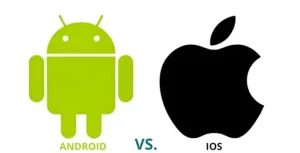
Android: It is Google LLC’s (limited liability company’s) mobile operating system for Android devices, focusing on touchscreen mobile devices such as smartphones and tablets. It was created using a variety of computer languages, including C, Java, C++, and others.
iOS: It is the operating system for Apple devices provided by Apple Inc., and it is the world’s second most popular mobile operating system behind Android. It is particularly intended for Apple mobile devices such as the iPhone, iPod Touch, and so on. It was created using a variety of programming languages, including Objective-C, Swift, C++, and others.
Difference between iOS and Android in iOS interview questions
|
Android |
iOS |
|
It is Google LLC’s (limited liability company’s) mobile operating system for Android devices, focusing on touchscreen mobile devices such as smartphones and tablets. It was created using a variety of computer languages, including C, Java, C++, and others. |
It is the operating system for Apple devices provided by Apple Inc., and it is the world’s second most popular mobile operating system behind Android. It is particularly intended for Apple mobile devices such as the iPhone, iPod Touch, and so on. It was created using a variety of programming languages, including Objective-C, Swift, C++, and others. |
|
It is built specifically for smartphones and tablets. |
It is built specifically for Apple iPhones, iPods, and iPads. |
|
Google Chrome is the default internet browser for Android smartphones. Any other browser, however, can be installed. |
On iOS devices, Safari is the default Internet browser. Any other browser, however, can be installed. |
|
The Android platform is accessible for various manufacturers, including Samsung, LG, and others, which may result in certain quality difficulties in lower-priced phones. |
iOS is subject to stringent quality control by Apple, and there are no quality issues. |
|
In comparison, Android devices contain open-source code, which means that owners may change the operating systems of their phones and tablets at their leisure. Owners who tamper (change/modify) with their gadgets excessively risk weakening their devices’ security. |
The iOS operating system is a closed system. Apple’s app source code is not available to developers, and iPhone and iPad owners cannot edit the code on their devices. This makes iOS-powered gadgets more difficult to hack. |
iOS Interview Questions for Intermediate level:
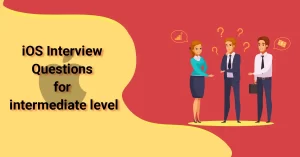
What generally do you mean when you say “deep linking” on iOS?
For intermediate level iOS interview questions the deep links are links that employ URI (Uniform resource location) or universal links to bring consumers to an app rather than a website or shop. The URL scheme is a well-known technique of creating deep connections, but Apple’s innovative strategy of connecting your web page and your app under the same link is called Universal Links. Deep linking entails not just providing a clickable link that starts your software, but also one that navigates to the desired resource. Using these links, users are routed directly to in-app places, saving them the time and effort of having to discover those sites themselves, greatly increasing their user experience.
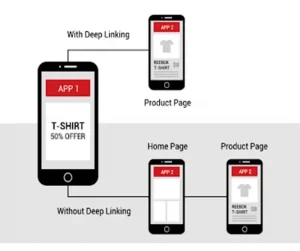
What is the concept of ARC (Automatic Reference Counting)?
For intermediate level iOS interview questions the automatic reference counting (ARC) is used in the Swift computer language to monitor app memory utilization. It initializes and deinitializes system resources, freeing memory reserved by a class instance when it is no longer required. ARC maintains track of how many properties, constants, and variables each class instance presently refers to. When an instance has at least one active reference to it, ARC will not deallocate it. The utilization of ARC principles is a critical component of iOS programming.
ARC Components –
- ARC uses init() to create a new class instance and allocates memory to hold the information.
- Memory is where information about the instance type and its values are stored.
- When a class instance is no longer needed, ARC automatically releases memory by using deinit ().
- ARC guarantees that deinit() is only executed to unneeded instances by tracking the attributes, constants, and variables of current referencing classes.
Explain the distinction between Cocoa and Cocoa Touch.
For intermediate level iOS interview questions the Cocoa and Cocoa Touch are two of Apple’s most popular application frameworks for developing applications. They do, however, contrast in the following methods:
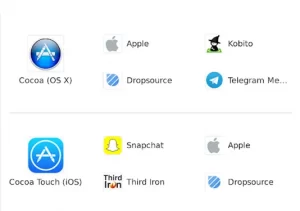
|
Cocoa |
Cocoa Touch |
|
It is an application platform for creating Mac OS X apps. |
It is the software platform used to create programs that run on devices such as the iPhone and iPad. |
|
Cocoa incorporates platforms such as Foundation and AppKit. |
Cocoa Touch is a collection of frameworks, including Foundation and UIKit. |
|
Cocoa classes utilize the NS prefix (which is used for all classes and constants in the Cocoa framework) (like NSTextField, NSWindow). |
Cocoa Touch classes, on the other hand, begin with the UI prefix (which is used for all classes and constants in the Cocoa Touch framework) (like UITextField and UIWindow). |
iOS interview questions for intermediate level.
Which programming languages are involved in the creation of iOS?
For intermediate level iOS interview questions the following application programs are used in iOS development:
- HTML5
- .NET
- C
- C++
- Swift
- Javascript
- Objective-C.
What is the framework used to create an iOS application’s interface?
For intermediate level iOS interview questions the UIKit is exclusively built for iOS programming, as opposed to the
Foundation framework, which includes classes, protocols, and functions for both iOS and OS X development. UIKit is used in iOS to create the application’s user interface and graphics architecture. It includes the following:
- Event management (handle different gestures like input gestures, button-tap gestures, multi-touch gestures, etc.)
- Structure of the app (Manages the interaction between the system and user)
- The User Interface (Provides user interactions, the ability to share text and content, select images, edit videos, print files, etc.)
- Graphic design, illustration, and printing
Write alternative methods for achieving concurrency in iOS?
For intermediate level iOS interview questions the concurrency is defined as “the ability to do many tasks at the same time.” Concurrency enables iOS devices to do background operations (such as downloading or processing data) while keeping a responsive user interface. Concurrent tasks in iOS may be managed via Grand Central Dispatch (or GCD), and Operations (formally known as NSOperation). iOS has three methods for achieving concurrency, which are as follows:
- Dispatch queues: Dispatch queues are used to handle jobs in first-in-first-out (FIFO) order and to execute activities sequentially or simultaneously. This is a simple method for handling asynchronous (tasks that do not occur at the same time) and concurrent tasks in your application.
- Threads: A thread is a sequence of instructions that can be run independently of other code inside a programme. Threads allow many code paths to be executed concurrently in a single programme. A thread is extremely handy when you need to execute a lengthy job without interfering with the remainder of the program’s execution.
- Operation Queues: Objects in the operation queue are activated based on their priority and readiness. Operation queues are essentially high-level abstractions of queueing models constructed on top of GCD (Grand Central Dispatch). As a result, jobs may be executed simultaneously, exactly like GCD, but in an object-oriented fashion.
What is the distinction between App ID and Bundle ID?
For intermediate level iOS interview questions the Bundle IDs are the unique identifiers for apps in Apple’s ecosystem. To put it another way, no two programs can share the same identifier. The bundling ID is used for both OS X and iOS programs and is used to identify app upgrades.
Example:
If our company’s domain is scaler.com and we construct an app called Edge, you might give it the bundle ID com.scaler.edge.
App ID: The string identifies one or more apps created by the same development team. The string is made up of two parts: the Team ID and the Bundle ID, which are separated by a period (.). Apple assigns a Team ID to a distinct development team, whereas developers assign Bundle IDs to a single app or a set of apps.
For instance, ABCDE12345.com.
scaler.edge
ABCDE12345 is the Team ID in the above example, and com.scaler.edge is the Bundle ID.
From the perspective of game development, what do you mean by the SpriteKit and SceneKit frameworks?
SpriteKit: This framework was created to help game developers build animated 2D assets/objects in casual games more easily and quickly. It allows you to draw two-dimensional shapes, particles, text, photos, and movies.
SceneKit – SceneKit is an iOS framework inherited from OS X that aids in the creation of 3D visuals. SceneKit allows you to create 3D animated scenes and effects for your iOS games and apps.
iOS Interview Questions for Experienced

In iOS, explain Objective-C.
For experienced level iOS interview questions, Apple has used Objective-C as an object-oriented programming language since the 1990s. This language combines the benefits of two previous languages: C and Smalltalk. It provides object-oriented capabilities and a dynamic runtime environment as a superset of C.
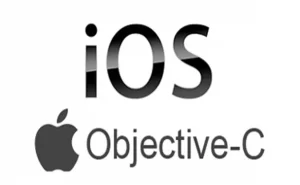
Features of objective C:
- Meta classes are automatically created and handled during runtime in Objective C.
- Both dynamic and static types are supported.
- It is simple to grasp.
What is Swift in iOS?
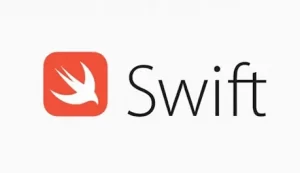
For experienced level iOS interview questions, Apple’s Swift programming language is the fastest-growing programming language today. Swift is the market leader in iOS programming, with a large advantage pool over the well-known Objective-C. It’s a whole new language designed exclusively for creating applications for Apple’s operating systems. Swift supports all of the features seen in other modern languages, including type inference, optional, generics, and other higher-order functions. It works with macOS, iOS, watchOS, and tvOS.
What are the main attributes of Swift?
For experienced level iOS interview questions, the Swift programming language was created so that developers may simply construct proper programmes and maintain them. It has the following characteristics:
- Safety:– Swift is a safe programming language to use. It is critical to test code before it is used in production. Before it is used in production, Apple Swift eliminates any hazardous code.
- Simple Syntax:– Swift’s syntax is clear and easy to use, precisely as developers would expect. Swift’s syntactic characteristics allow you to build more expressive code.
- Understandability: Swift’s syntax is straightforward, making it easy to read and write. Swift code is easier for developers to create since it is more akin to plain English, allowing them to spend less time searching for incorrect code.
- Multiplatform support: Swift is entirely interoperable with iOS, macOS, tvOS, watchOS, Linux, and a variety of other systems. This implies you can create software that works with all operating systems.
- Open-source: Swift is an open-source framework that is developed at swift.org. Swift’s technology is required to be available to anyone in order for it to become a leading programming language. Swift is compatible with all Apple platforms and improves programming simpler, quicker, and safer.
- Integrated with Objective-C: Swift is completely compatible with Objective-C. Swift allows programmers to use the Swift syntax to import frameworks from Objective-C. Objective-C libraries and classes can be used within Swift programs by programmers.
Explain TDD (Test-Driven Development).
For experienced level iOS interview questions, Testing-driven development (TDD) can be used by software engineers in the creation of software. TDD requires developers to outline the software features they want to develop
and then write unit tests for each feature before developing it. We can acquire insight into both the quality of the implementation (does this really function) and the quality of the design by using test-driven development (is it well structured).
The test case will initially fail because the code has not yet been implemented; this is known as the red phase. Following that, code is built to guarantee that the test case passes without breaking any subsystems or current test cases, which is referred to as the green phase.
Explain the completion handler’s function.
For experienced level iOS interview questions, Completion handlers are just functions that are supplied as arguments to other functions. Because we don’t know when delayed jobs will conclude, they’re used to dealing with their responses. When an action, such as an API request, is done, completion handlers notify the application. The software is notified that the following step must be performed.
Let’s make a basic class named CompletionHandler with one function called count that counts from 0 to 50. It will send a network request to https://scaler.com whenever it hits 25 (a random value). We will display Received answer after the query has been finished.
class CompletionHandler {
func count() {
for i in 0…50 {
if i == 25 {
if let url = URL(string: “https://scaler.com”) {
URLSession.shared.dataTask(with: url) { (data, response, error) in
print(“Received response”)
}.resume()
}
}
print(“I = “, i)
}
}
}
let newInstance = CompletionHandler()
newInstance.count()
|
All of the numbers will be printed in the console as soon as the code is executed, however the Received response will indeed be printed only after all of the other numbers have been printed. |
What is the JSON framework that iOS supports?
For experienced level iOS interview questions, As a JSON framework, iOS supports the SBJson framework. This lightweight data interchange format is simple to read and write for both humans and computers. SBJson’s broad APIs and greater control make JSON processing easier.
Describe iBeacons on iOS.
For experienced level iOS interview questions, Apple’s new low-energy Bluetooth wireless network, iBeacon, enables iPhone and other iOS users to get location-based information services on their handsets. IBeacons are miniature wireless transmitters that use Bluetooth low-energy technology to send signals to neighboring smart devices.
What specifically do you mean by “dynamic dispatch”?
For experienced level iOS interview questions, In layman’s words, dynamic dispatch implies that the program selects the implementation of a certain method or function to execute at runtime. When a subclass overrides a method of its superclass, dynamic dispatch chooses whether to execute the method’s subclass implementation or the parents.
How do you remain up to date with Swift changes?
For experienced level iOS interview questions, Approach suggestion: We are developing in a rapidly changing environment, not least because Apple updates all of their main versions every year. Prepare to discuss books you’ve read, websites you’ve visited, newsletters you’ve subscribed to, conferences you’ve attended, and more — the more detailed, the better, because it demonstrates that you’re working hard to keep current.
What is the aim of Xcode code signing?
For experienced level iOS interview questions, Developers condemn code signing because it is inconvenient, but consider it from Apple’s perspective, in terms of proving a developer just who they say they are, as well as how provisioning profiles allow functionality.
Once there, I’d relate it to the significance of strict security on the App Store, considering validating developer IDs is one of the numerous stages toward selling secure apps.
Conclusion:
Apple gadgets are used by billions of people throughout the world. The number of iOS users globally has been constantly increasing, which is good news for iOS app developers. Here are the best iOS interview questions and answers. If you want to pursue a career in iOS application development, then this is a great place to start.
In these iOS interview questions, we’ve compiled 30+ of the most often asked iOS interview questions to help you ace your iOS job interview. iOS developers must also keep up with developments in the iOS community. Make sure to read Apple developer updates, podcasts, and blogs as well. In the iOS interview questions and answers this is unlikely to be a discussion in an interview, but it distinguishes you.
Hopefully, these iOS interview questions and answers will aid in your comprehension of iOS fundamentals, Swift, and advanced topics. Knowing the answers to these Swift and iOS developer interview questions can help you succeed in your iOS interview with these curated iOS interview questions and answers. Best wishes for your iOS interview questions and answers!
Frequently Asked Question’s
1. What should I do to prepare for an iOS interview?
Well buckle up because we’ll break this down into five steps in these iOS interview questions!
- Recognize the Issue. Out loud, restate the problem to yourself.
- Consider the solution aloud.
- In code, suggest and discuss a solution.
- Create and validate code.
- Improve and optimize.
- Additional Suggestions.
This is a frequently asked question in iOS interview questions.
2. What are the three sorts of interview responses?
Well, how do you discern the difference between
- Situational
- Competency-based
- Behavioral inquiries
To keep things easy at first, this table divides the three sorts of interview guides you’re likely to face — and explains why they’re asked. It is an important iOS interview questions.
3. Which is superior, Swift or Objective C?
Swift, according to Apple, is nearly 2.6 times quicker than Objective C. Swift allows you to code at a substantially faster rate than Objective C. Swift’s syntax is simpler and more straightforward. Apple’s Swift programming language is the fastest-growing programming language today. This is a frequently asked question in iOS interview questions.
Swift is the market leader in iOS programming, with a large advantage pool over the well-known Objective-C. It’s a whole new language designed exclusively for creating applications for Apple’s operating systems. Swift supports all of the features seen in other modern languages, including type inference, optional, generics, and other higher-order functions. It works with macOS, iOS, watchOS, and tvOS. This is an important iOS interview questions.
4. What makes Swift quicker than Objective C?
In this iOS interview questions, Swift is quicker than Objective-C because it eliminates the constraints of the C language and has been enhanced with sophisticated software development capabilities that were not accessible when C was created. Swift, as indicated by Apple, was originally meant to be speedier. This iOS interview questions is frequently asked in interviews.
Apple’s Swift programming language is the fastest-growing programming language today. Swift is the market leader in iOS programming, with a large advantage pool over the well-known Objective-C. It’s a whole new language designed exclusively for creating applications for Apple’s operating systems. Swift supports all of the features seen in other modern languages, including type inference, optional, generics, and other higher-order functions. It works with macOS, iOS, watchOS, and tvOS. iOS interview questions.
Apple has used Objective-C as an object-oriented programming language since the 1990s. This language combines the benefits of two previous languages: C and Smalltalk. It provides object-oriented capabilities and a dynamic runtime environment as a superset of C. This is an important iOS interview questions.
5. Is it difficult to get recruited at Apple?
Getting a job at Apple, like many of these digital monoliths, may be a difficult task. In fact, obtaining full-time employment is sometimes considered unattainable, due to Apple’s stringent and demanding qualifications for becoming a full-time associate. This is an important iOS interview questions.
The salary range for a Software Engineer at Apple goes from 12.6 lakhs to 51 lakhs. Salary estimates are based on data from 70 Apple workers. Apple’s Vice President receives the greatest money, with a yearly compensation of INR 61.4 lakhs. The top 10% of employees earn more than INR 40.18 lakhs per year. This is an important iOS interview questions.
6. What is the architecture of iOS?
In this iOS interview Questions a layered architecture. The iOS interview questions architecture is divided into four levels, each of which provides a programming foundation for developing programs that run on top of the hardware. The levels between the Application Layer and the Hardware Layer will improve communication. A lower-level layer offers services required by all programs, whereas an upper-level layer (or high-level layer) delivers graphics and interface-related functions. This is an important iOS interview questions.
- Core OS (or Application) Layer: The Core OS Layer is the bottom layer of the iPhone OS stack and sits directly on top of the device hardware. This layer enables low-level networking, access to external accessories, and other services in addition to core operating system functions like memory management, file system and thread handling.
- Service Object- The objective of the Service Layer is to design the services that upper levels or users require. Block objects, Grand Central Dispatch, in-app purchases, and iCloud storage are among its other major features. The implementation of ARC Automatic Reference Counting has enhanced the service layer.
- Media Layer: It is in charge of media such as video, audio, graphics, and so on. The media layer will allow us to leverage the system’s graphics, video, and audio technologies.
- Cocoa Touch Layer : The Cocoa Touch Layer is often referred to as the application layer. When applications are generated, frameworks are created in this location. It also serves as an interface for iOS users to interact with the operating system. This includes the ability to use touch and motion which is important in iOS interview questions.
7. What are iOS design patterns?
Design patterns are reusable solutions to common software design challenges. They are templates meant to assist you in writing code that is simple to comprehend and reuse. They also assist you in writing loosely linked code, which allows you to easily update or replace components in your code. This is an important iOS interview questions.
8. What is the iOS development language?
Swift is an extremely powerful and user-friendly language of programming for iOS, iPadOS, macOS, tvOS, and watchOS. Swift code is interactive and enjoyable to write, the syntax is compact yet expressive, and Swift offers current features that developers adore. This is an important iOS interview questions.
The Swift programming language, developed and maintained by Apple, is used to write the majority of current iOS apps. Another common language that may be seen in older iOS apps is Objective-C. Although Swift and Objective-C are the most popular programming languages, iOS apps may also be created in other languages. This is an important iOS interview questions.
10. What exactly is MVVM on iOS?
MVVM (Model View ViewModel) is a template that has become increasingly popular as more event-driven systems have emerged. A few years ago, if somebody developed a product, it was almost always built using MVC (Model View Controller).
The MVC architecture has recently lost its role as the primary design pattern.
The display and controller are tightly connected and regarded as one component in the MVVM design paradigm. It may alternatively be represented as UIView or UIViewController objects, which are accompanied by.xib and.storyboard files. This is an important iOS interview questions.

